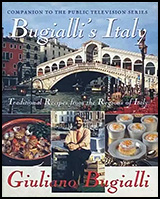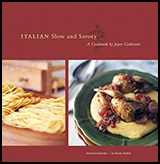When I was looking at apartments last year, one of the selling points that El Cerrito landlords touted was that, as a resident, I would be able to take advantage of the town’s gigantic recycling center, which takes in all sorts of things I’d had piling up: old computers, glasses with old prescriptions, cardboard boxes, you name it. And since I did end up moving to El Cerrito, the recycling center was one of the first places in town I checked out. It turns out that in addition to taking in residents’ recyclable detritus, it also offers up a media exchange area with a small library’s worth of books free for the taking. The cookbooks I found were mostly ancient and not of much interest to me, but here are a few I did snag and have been cooking out of for the past few months.
 Bugialli’s Italy
Bugialli’s Italy Giuliano Bugialli, 1998
This is the companion book to a PBS series I hadn’t heard of, and I soon found myself musing that it had wound up at the recycling center for a reason. Rosemary pasta was flat-out bad and I had to add a bunch of other ingredients to make it palatable. Following the directions for the leek risotto resulted in a dish full of rock-like potatoes, and I had to go rogue and add a lot more broth and a lot more cooking time, so the finished product was what the judges on Masterchef Australia would call “claggy” (which I actually like). Other recipes were more successful, but underwhelming: a white bean and chard dish had no alchemy and was ultimately just a big bowl of chard, stewed cabbage was fine but forgettable… the one recipe I did put on my make-again list was a stewed artichoke dish, but otherwise, this one was skippable. One odd note: every single recipe says to soak the vegetables for half an hour before doing any other steps. I did not find that that made much difference.
 Bugialli on Pasta
Bugialli on Pasta Giuliano Bugialli, 2000
After my experience with the previous book, my expectations for this one were low, and I wondered how different these recipes could be from the many, many other pasta recipes in my rotation. But as it turned out, even though I’ve only scratched the surface so far (half a dozen recipes, all from the easiest section), this one’s a winner. Really basic recipes revolving around a single ingredient like zucchini or arugula turned out to be surprisingly delicious despite their simplicity, and the flavor profiles were a change of pace from my other pasta cookbooks: peperonata was thick and dark, for instance. I look forward to trying some of the more ambitious sections.
 Italian Slow and Savory
Italian Slow and Savory Joyce Goldstein, 2004
At the library I often find lots of cookbooks promising to make quick work of dinner: “Food Made Fast”! “Fifteen-Minute Meals”! This one promises the exact opposite. One page mentions a recipe the author likes but has chosen not to include because it doesn’t take enough time to prepare! So, yeah, lots of recipes involving twenty minutes of chopping, an hour of simmering, and forty minutes of baking. But the results have been very good! A lot of these recipes are just grain bowls of varying consistencies—mushroom and hazelnut farro, polenta and kale soup, risi e bisi, etc.—but I have not yet regretted the two-hour wait. And I’ve tried a few things outside my usual beat: a spring vegetable pie that took forever to bake since the oven here runs annoyingly cold, but again, worth the wait; an asparagus pudding that looked gross but tasted delightful; an unusual appetizer of artichokes in a tangerine sauce. And this cookbook was just sitting on a shelf waiting to be snapped up for free!
 Vegetarian Pizza
Vegetarian Pizza James McNair, 1993
I should note that none of the cookbooks above are vegetarian, so my assessments are based on a small fraction of the recipes included therein. This one is vegetarian, but I cooked an even smaller fraction. If this had been even a quarter rather than free, I probably wouldn’t have picked it up, because I’ve never seen the point of making pizza at home: I’ve never been able to get it to turn out well, and in the Bay Area, great pizza is not hard to come by, so why bother? And I certainly wasn’t going to have my mind changed by this book’s photos, which constitute some of the ugliest food photography I’ve ever seen. And I’ve been to James Lileks’s site. But it did inspire me to pull the old pizza stone out from under the day bed and try to make my results look better than the picture. I started with the asparagus and egg pizza, then the summer squash and ricotta, and at that point I had my own ideas about how to make the pizza turn out better (switching oven locations midway through, shelling out for a real pizza peel, etc.), and so even though I only tried one more pizza from the book (potato leek), it did finally give me the push I needed to add pizza to my cooking rotation and steadily improve at it. I don’t even set off the fire alarm anymore!
 |
 |
 |
 |
||
|---|---|---|---|---|---|
Tumblr |
this site |
Calendar page |
|||